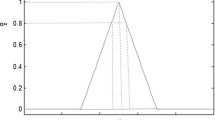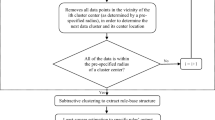Abstract
Process data provide important information for monitoring product quality. A common problem of process readings is their deviation from in-control values due to systematic errors or instrument biases. Timely detection and modification of instrument fault is crucial for process manipulation. Monitoring changes in process mean and variance simultaneously is important because special causes can evoke changes in both at once. Many existing methods identify either the mean or variance only; some even inaccurately assumes that the in-control parameters are known. We propose a new method called fuzzy maximum likelihood change-point (FMLCP) algorithm that allows detection of the time of shifts in mean and variance simultaneously without knowing the in-control parameters. The fuzzy c-partition concept is embedded into change-point formulation to deal with the vagueness of boundaries between adjacent segments. An FMLCP procedure is constructed and suitable for processes following any distribution. The FMLCP algorithm can be applied to both phase I and II processes in quality control without any information of in-control parameters; multiple change points are allowed and the shifts in each individual segment can be estimated simultaneously. Our experimental results demonstrate the preferred utility of FMLCP over traditional statistical maximum likelihood approaches. We used real datasets to demonstrate the effectiveness of FMLCP. Using FMLCP to detect small shifts is particularly beneficial for identifying root causes quickly and correctly in phase II applications where small changes occur more often and the average run length tends to be long.











Similar content being viewed by others
References
Gan FF, Ting KW, Chang TC (2004) Interval charting schemes for joint monitoring of process mean and variance. Qual Reliab Eng Int 20:291–303
Keshavarz M, Huang B (2015) Expectation maximization method for multivariate change point detection in presence of unknown and changing covariance. Comput Chem Eng 69:128–146
Niaki STA, Khedmati M (2013) Change point estimation of high-yield processes with a linear trend disturbance. Int J Adv Manuf Technol 69:491–497
Niaki STA, Khedmati M (2014) Change point estimation of high-yield processes experiencing monotonic disturbances. Comput Ind Eng 67:82–92
Eyvazian M, Noorossana R, Saghaei A, Amiri A (2011) Phase II monitoring of multivariate multiple linear regression profiles. Qual Reliab Eng Int 27(3):281–296
Shams I, Ajorlou S, Yang K (2013) Modeling clustered non-stationary Poisson processes for stochastic simulation inputs. Comput Ind Eng 64:1074–1083
Dogu E (2014) Change point estimation based statistical monitoring with variable time between events (TBE) control charts. Qual Technol Quant Manag 11:383–400
Hawkins DM, Qiu PH, Kang CW (2003) The changepoint model for statistical process control. J Qual Technol 35:355–366
Hawkins DM, Zamba KD (2005) A change-point model for a shift in variance. J Qual Technol 37:21–31
Ross GJ, Adams NM, Tasoulis DK, Hand DJ (2011) A nonparametric change point model for streaming data. Technometrics 53:379–389
Ross GJ, Adams NM (2012) Two nonparametric control charts for detecting arbitrary distribution changes. J Qual Technol 44:102–116
Ahmadzadeh F (2009) Change pointdetection with multivariate control charts by artificial neural network. Int J Adv Manuf Technol. doi:10.1007/s00170-009-2193-6
Amiri A, Niaki STA, Moghadam AT (2015) A probabilistic artificial neural network-based procedure for variance change point estimation. Soft Comput 19:691–700
Chen CWS, Chan JSK, Gerlach R, Hsieh WYL (2011) A comparison of estimators for regression models with change points. Stat Comput 21:395–414
Keshavarz M, Huang B (2015) Expectation maximization method for multivariate change pointdetection in presence of unknown and changing covariance. Comput Chem Eng 69:128–146
Fearnhead P (2006) Exact and efficient Bayesian inference for multiple change point problems. Stat Comput 16:203–213
Harnish P, Nelson B, Runger G (2009) Process partitions from time-ordered clusters. J Qual Technol 41:3–17
Ghazanfari M, Alaeddini A, Niaki STA, Aryanezhad MB (2008) A clustering approach to identify the time of a step change in Shewhart control charts. Qual Reliab Eng Int 24:765–778
Lu KP, Chang ST, Yang MS (2016) Change-point detection for shifts in control charts using fuzzy shift change-point algorithms. Comput Ind Eng 93:12–27
Kazemi MS, Bazzrgan H, Yaghoobi MA (2014) Estimating the drift time for processes subject to linear trend disturbance using fuzzy statistical clustering. Int J Prod Res 52:3317–3330
Alaeddini A, Ghazanfari M, Aminnayeri M (2009) A hybrid fuzzy-statistical clustering approach for estimating the time of changes in fixed and variable sampling control charts. Inf Sci 179:1769–1784
Zarandi MHF, Alaeddini A (2010) A general fuzzy-statistical clustering approach for estimating the time of change in variable sampling control charts. Inf Sci 180:3033–3044
Hawkins DM, Zamba KD (2005) Statistical process control for shifts in mean or variance using a changepoint formulation. Technometrics 47:164–173
Park J, Park S (2004) Estimation of the change-point in the \(\bar{X}\) and S control charts. Commun Stat Simul Comput 33:1115–1132
Montgomery DC (2013) Introduction to statistical quality control, 7th edn. Wiley, New York
Chang ST, Lu KP (2016) Detecting change-points in statistical process control using EM change-point algorithm. Qual Reliab Eng Int 32:889–900
Zadeh LA (2008) Is there a need for fuzzy logic? Inf Sci 178:2751–2779
Wang D, Li P, Yasuda M (2014) Construction of fuzzy control charts based on weighted possibilistic mean. Commun. Stat. Theory Methods 43:3186–3207
Sentürk S, Erginel N, Kaya I, Kahraman C (2014) Fuzzy exponentially weighted moving average control chart for univariate data with a real case application. Appl Soft Comput 22:1–10
Faraz A, Shapiro AF (2010) An application of fuzzy random variables to control charts. Fuzzy Set Syst 161:2684–2694
Chen YK, Chang HH, Chiu FR (2008) Optimization design of control charts based on minimax decision criterion and fuzzy process shifts. Expert Syst Appl 35:207–213
Hsieh KL, Tong LI, Wang MC (2007) The application of control chart for defects and defect clustering in IC manufacturing based on fuzzy theory. Expert Syst Appl 32:765–776
Bradshaw CW (1983) A fuzzy set theoretic interpretation of economic control limits. Eur J Oper Res 13:403–408
Hawkins DM (2001) Fitting multiple change-point models to data. Comput Stat Data Anal 37:323–341
Zadeh LA (1965) Fuzzy sets. Inf Control 8:338–353
Ruspini EH (1969) A new approach to clustering. Inf Control 15:22–32
Yang MS (1994) On a class of fuzzy classification maximum likelihood procedures. Fuzzy Set Syst 57:365–375
Venter JH, Steel SJ (1996) Finding multiple abrupt change points. Comput Stat Data Anal 22:481–504
Hsu DA (1979) Detection shifts of parameter in gamma sequences with application to and air traffic flow analysis. J Am Stat Assoc 74:31–46
Lee CB (1998) Bayesian analysis of a change-point in exponential families with applications. Comput Stat Data Anal 27:195–208
Habibi R (2011) Change point detection using bootstrap methods. Adv Model Optim 13:341–347
Jandhyala VK, Fotopoulos SB, Hawkins DM (2002) Detection and estimation of abrupt changes in the variability of a process. Comput Stat Data Anal 40:1–19
Lombard F (1987) Rank tests for changepoint problems. Biometrika 74:15–624
Fearnhead P, Clifford P (2003) Online inference for hidden Markov models. J R Stat Soc Ser B 65:887–899
Ruanaidh JJK, Fitzgerald WJ (1996) Numerical Bayesion methods applied to signal processing. Springer, New York
Neubauer J, Vesely V (2013) Detection of multiple changes in mean by sparse parameter estimation. Nonlinear Anal Model Control 18:177–190
Gustafsson F (2000) Adaptive filtering and change detection. Wiley, Hoboken. ISBN 978-0-470-85340-5
Bai X, Yao W, Boyer JE (2012) Robust fitting of mixture regression models. Comput Stat Data Anal 56:2347–2359
Acknowledgements
This study was partially supported by the Ministry of Science and Technology, Taiwan [Grant Number Most 105-2118-M-025-002 and Most 105-2118-M-003-001] and National Taiwan Normal University [Grant Number 104000138].
Author information
Authors and Affiliations
Corresponding author
Ethics declarations
Conflict of interest
The authors declare that they have no conflict of interest.
Rights and permissions
About this article
Cite this article
Lu, KP., Chang, ST. Fuzzy maximum likelihood change-point algorithms for identifying the time of shifts in process data. Neural Comput & Applic 31, 2431–2446 (2019). https://doi.org/10.1007/s00521-017-3200-8
Received:
Accepted:
Published:
Issue Date:
DOI: https://doi.org/10.1007/s00521-017-3200-8




